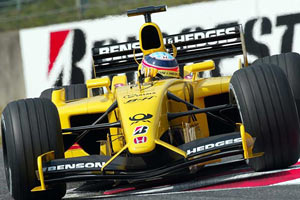Jordan Honda EJ12

Active: 2002
Team: Jordan Grand Prix Ltd
Designer: Egbal Hamidy (TD), Tom Holloway (Head of engineering), Gary Anderson (Head of test and race engineering)
Drivers: Giancarlo Fisichella (9), Takuma Sato (10)
Team name: DHL Jordan Honda
The Jordan Honda EJ12 debuted at the South circuit at Silverstone on January 22. Before Japanese rookie Takuma Sato was lucky to drive it, staff at Jordan's Silverstone factory worked throughout the weekend, completing the final build of Jordan's 2002 season challenger in the early hours of Monday morning. Just before lunch, Sato drove the EJ12 for the first time, in front of engineers, mechanics, designers from the drawing office, and Jordan's Chief Executive, Eddie Jordan.
One month later, on Friday 22 Februari, the team was officially unveiled at a DHL hangar at Brussels airport. While long term lead sponsor Benson & Hedges stayed on the car, the team's name and largest sponsor area was taken by DHL, a courier owned by Deutsche Post. According to an article in Haymarket's Marketing magazine, the deal was worth around £20million a season to the team and was planned to last for three years.
However, as the EJ12 performed largely below expectations, neither DHL or Deutsche Post were seen on next year's Jordan. The car totalled 9 points at the end of the season, having finished 6th once and four times 5th. It still proved better than BAR Honda, the other team powered by the Honda RA002E.
The Jordan Honda EJ12 is an entirely new design, based on its predecessor, the EJ11. A new carbon fiber monocoque is complimented by a dramatic looking aerodynamic package featuring a swooping front nose section, whilst the all-new Honda RA002E engine is mated to a revised 7-speed Jordan transmission.
In overall charge of the project was Head of Engineering, Tim Holloway: "My role is to oversee and coordinate the design, to get the car running efficiently in time for its first test. From its main concept to overall performance, the car is the responsibility of Technical Director Eghbal Hamidy. I have an input on the design, making sure we are moving in the right direction and the ideas we are trying are indeed practical. Eghbal works with a design team of around fifty people, operating under two joint chief designers, a head of aerodynamics and a design group. Within it there are six of us who thrash out and expand on ideas. The various areas then work on their programs based on what comes out of the meetings. The car is designed by committee. It is impossible for one man to design an F1 car these days. Everyone is working flat out and it is still a difficult task. Within that committee, you have the mechanical designers, the composite designers, aerodynamic designers, the vehicle dynamicists and the race engineering department. Everyone has their input."
Development process
Pinpointing a specific date when design on EJ12 began is impossible, as some of the work carried out in the wind tunnel to improve EJ11 during 2001, has been carried over to the new car.
"We try to work out when we want the car to be launched and work back from the production schedule to see when each component must be designed, in order for it to be made in time," explains Tim Holloway. All in all, the whole chassis design program lasts about 26 weeks, from initial design to having the first chassis in the workshop:
- The longest lead times are the chassis assembly - and the gearbox - 6 weeks from initial concept to fitting on the car.
- Suspension: an upright takes 10 weeks.
- Rear pushrod: about a month.
- Dampers: 6 weeks
- Front brake ducts: one month
"You could sign off parts much earlier, but the idea is to hold back as long as possible to maximize performance," says Holloway. "Of course, you can always change the design of components during the season, but that is far more expensive than simply delaying their initial production to take in the latest results of research in the wind tunnel.
"Bear in mind this list is to produce one component and of course by the time we are setting off for Melbourne, we might need six of them. Of course that doesn’t take six times as long, as you can use more moulds. In reality the second edition of any part can take half or a third of the time."
Specifications
Chassis/body: Full carbon fibre composite monocoqueFront suspension: Composite pushrods activating chassis mounted Penske dampers and torsion bars, unequal length aerodynamic wishbones, composite top and bottom wishbones, fabricated uprights and front anti-roll bar
Rear suspension: Composite pushrods activating gearbox mounted Penske dampers, unequal length aerodynamic wishbones, composite wishbones, fabricated uprights and rear anti-roll bar
Brakes: Carbon discs, all-round
Gearbox: 7 speed Semi-automatic
Drive: Rear wheel drive
Tyres: Bridgestone
Dampers: Penske
Clutch: Triple plate Jordan/AP racing clutch
Dimensions:
- Weight: 600 kg
- Length: 4600 mm
- Height: 950 mm
- Wheelbase: 3000 mm
- Front track: 1500 mm
- Rear track: 1418 mm
Engine specifications
Engine: Honda RA002E V10
Engine Location: Mid , longitudinally mounted
Displacement: 3.000 liter
Valvetrain: 4 valves / cylinder, DOHC
Fuel feed: Honda PGM Fuel injection
Aspiration: Naturally Aspirated

